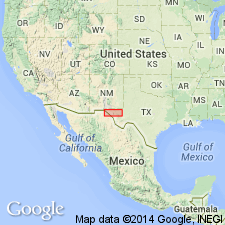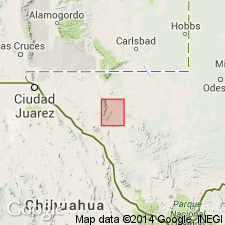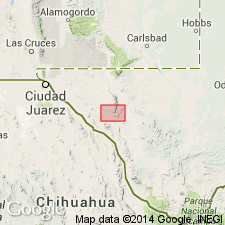
- Usage in publication:
-
- Van Horn formation
- Modifications:
-
- Original reference
- Dominant lithology:
-
- Sandstone
- Conglomerate
- AAPG geologic province:
-
- Permian basin
Summary:
Pg. 28, geol. map. Van Horn formation. Massive coarse red sandstone and conglomerate in red valley northwest of Van Horn and in southern Diablo Mountains. Thickness 0 to 500 or more feet. No fossils, but tentatively assigned to Cambrian. Probably younger than Bliss sandstone. Unconformity at base. Merges upward into varicolored sandstone and white calcareous sandstone containing Early Ordovician (uppermost Calciferous) fossils. [Age is Late Cambrian.]
Named from Van Horn, El Paso Co. [now in Hudspeth Co.], western TX. (Most complete section in red valley northwest of Van Horn, where about 500 ft exposed.)
Source: US geologic names lexicon (USGS Bull. 896, p. 2233).

- Usage in publication:
-
- Van Horn sandstone*
- Modifications:
-
- Revised
- Overview
- AAPG geologic province:
-
- Permian basin
Summary:
Revised--unconformably overlies (in places) the newly named pre-Cambrian? Millican formation in report area, Van Horn quadrangle, Hudspeth and Culberson Cos, TX in Permian basin. Van Horn overlies Millican at north end of Beach Mountain and at the southeast end of Sierra Diablo. Van Horn outcrops principally in an area of about 10 sq mi in the valley between Beach Mountain and the Texas and Pacific RR. Normally Van Horn is directly overlain by Lower Ordovician El Paso limestone. Van Horn ranges in thickness from a few ft to 700 ft. Age is Late Cambrian?, based on stratigraphic relations. Geologic, structural, and topographic maps. Columnar section.
Source: GNU records (USGS DDS-6; Denver GNULEX).

- Usage in publication:
-
- Van Horn sandstone*
- Modifications:
-
- Revised
- Age modified
- AAPG geologic province:
-
- Permian basin
- Southwestern Basin-and-Range region
Summary:
Pg. 145 (table), 152-153. Van Horn sandstone as defined by Richardson (1904), Van Horn region, Culberson and Hudspeth Counties, Texas (Permian basin), included red arkosic sandstones below and white quartzose sandstones above; the two parts were supposed to be conformable. Subsequent work has shown that the two parts of original formation are separated by well-marked unconformity. Proposed here to restrict name Van Horn to lower red arkosic part of original formation. Upper part included in Bliss sandstone. Maximum thickness of restricted Van Horn about 700 feet. Rests on truncated edges of Allamoore (new) and Hazel (reinstated) formations; rocks formerly †Millican formation of Richardson (1914). Age is Cambrian and Precambrian. Report includes stratigraphic chart, regional sketch map.
Source: US geologic names lexicon (USGS Bull. 1200, p. 4056); supplemental information from GNU records (USGS DDS-6; Denver GNULEX).
For more information, please contact Nancy Stamm, Geologic Names Committee Secretary.
Asterisk (*) indicates published by U.S. Geological Survey authors.
"No current usage" (†) implies that a name has been abandoned or has fallen into disuse. Former usage and, if known, replacement name given in parentheses ( ).
Slash (/) indicates name conflicts with nomenclatural guidelines (CSN, 1933; ACSN, 1961, 1970; NACSN, 1983, 2005, 2021). May be explained within brackets ([ ]).

